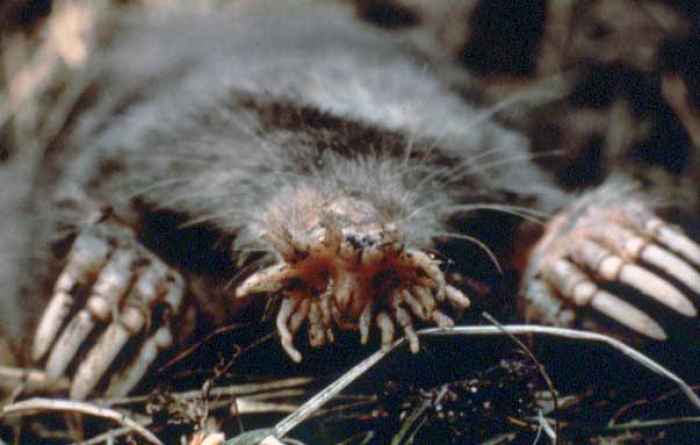What to do when molehills become mountains of annoyance
Published 3:10 pm Thursday, March 22, 2018

- The star-nose mole is a protected species that may not be trapped or poisoned in NC, but most local moles do not have such protections. Photo from National Park Service
By Amy-Lynn Albertson
Special to the Salisbury Post
As spring finally begins, many homeowners have been calling with complaints about moles in their yard.
Moles can be distinguished from voles and shrews by some of their characteristics. Moles have a hairless pointed snout in front of the mouth. They have small eyes that are hidden by fur, and they do not have external ears. Their forefeet are large and broad with webbed toes.
Moles swim through soil near the ground surface in search of worms, insects, and other foods. Moles are solitary and make their burrows in high, dry spots, but they prefer to hunt in soil that is shaded, moist and populated by worms and grubs.
On large properties, mole activity may move from one part of the lawn to another, according to climate and ground moisture. Moles respond to changes in the food supply as different insects become available in different places and at various times throughout the year.
If disturbed, moles may temporarily leave an area but will usually return when you least expect it. Even without disturbance, mole activity may last only a week or two in a particular area.
What they like
Over-watering your lawn or excess rainfall can bring grubs, worms and moles closer to the surface. Reducing the amount or frequency of watering may help temporarily.
Reducing the amount of turfgrass on your property will also reduce the visible signs of damage. In the long run, converting lawn to gardens, paths, hedgerows or other more natural habitats can save you time and money as well as provide habitat for beneficial birds and butterflies.
There are many home remedies for getting rid of moles, but all are mostly ineffective.
Pickle juice, broken glass, red pepper, razor blades, bleach, moth balls, rose branches, human hair, vibrators, ultrasonic devices, castor bean derivatives (castor oil) and explosives may relieve frustrations, but they have little value in controlling moles and may harm you or the environment. Furthermore, certain chemicals or explosives are illegal to use.
Toxic baits may not work
In 2014, the N.C. Pesticide Board declared eastern moles (Scolopus aquaticus) and hairy-tailed moles (Parascalops breweri) as pests, and made it legal to use pesticides to control them. Manufacturers have been submitting their products for registration. Some products have been approved for use, and other products are still awaiting approval.
This means that you can use pesticides registered to control the eastern mole and the hairy-tailed mole in turf in the following areas: residential; commercial; government property, excluding federal and state parks; golf courses, driving ranges, and golf instructional facilities; sod farms; athletic fields; and/or visitor centers and cemeteries.
Mole pesticides cannot be used in pastures and should not be applied within 100 feet of natural or man-made bodies of water such has streams, rivers, ponds, swamps, lakes and wetlands — nor at elevations of 4,000 feet or more.
Registered products include Motomco Mole Killer, Talpirid, Tomcat Mole Killer and Victor Moleworms. Information from the University of Missouri indicates that the efficacy of toxic baits is questionable. Many of the toxic baits rely on a grain, seed or nut base to deliver the chemical. However, moles do not prefer grains as a meal. Products that mimic a grub or worm may be a better choice.
Star-nosed moles (Condylura cristata) are native to Eastern North America up to Canada and can be found in North Carolina, mostly dwelling in the mountains and Coastal Plain. This mole is a protected species of special concern in the state and therefore illegal to trap or kill. They live in lowland areas with wet soil such as swamps and marshes and are found along streams or springs in more high-elevation areas such as mountains. They are semi-aquatic, so they spend the majority of their lives underground or underwater and are powerful swimmers.
Take away their food
One way to help control moles is to take a non-lethal approach. This means that their food source must be reduced.
Grubs can easily be controlled in the lawn through a chemical application. The timing of the insecticide application is critical if control is to be effective. There are two approaches, preventative and curative.
Preventative: Some of the newer products (Merit and Mach 2) are preventative and are most effective when applied before eggs are laid in late June early July. This approach should only be used in areas that have a history of grub infestations.
Curative: The curative approach is used when an existing infestation is detected. The best time to apply curative insecticides is when the grubs are actively feeding near the soil surface. Pesticides applied any other time will be ineffective. Feeding occurs from August through October, and again in April through early May.
Curative treatments with active ingredients like carbaryl and Bt, applied in late summer or fall, are usually more effective than spring applications because the grubs are small.
When using any chemical always follow the label instructions for proper application. For more information on mole and grub control contact the Rowan County Extension office at 704-216-8970.
(The use of brand names in this publication does not imply endorsement of the products or services named or criticism of similar ones not mentioned.)
Amy-Lynn Albertson is county extension director and agriculture-horticulture extension agent in the Rowan County Cooperative Extension Service.




